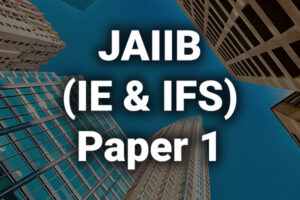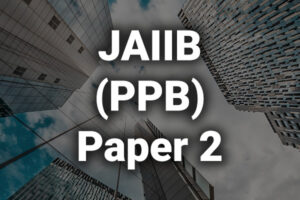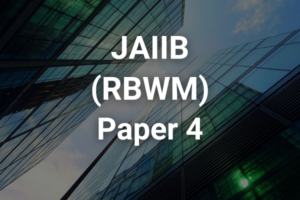The JAIIB examination is exclusively available to regular members of the Institute. Any individual employed in the banking and finance sector, whose employer is an Institutional member of the Institute, is eligible to apply for membership.
The JAIIB Examination has four papers
-
Indian Economy & Indian Financial System
-
Principles & Practices of Banking
-
Accounting & Financial Management for Bankers
-
Retail Banking & Wealth Management
JAIIB Examination Pattern
-
The question paper will consist of around 100 objective multiple-choice questions, totaling 100 marks.
-
The examination will be conducted exclusively in online mode.
-
There will be no negative marking for incorrect answers
JAIIB Marking Scheme
Typical JAIIB Marking Scheme consists of
-
50 questions of 0.5 marks
-
25 questions of 1 marks
-
25 questions of 2 marks
Indian Economy & Indian Financial System (IEFS) Paper 1
Important Topics
#ppb
Module A: Indian Economic Architecture |
||
S.no |
Chapters |
Important Topics |
1 |
Sectors of the Indian Economy |
Role & Importance of the Sectors, Difference between the sectors |
2 |
Economic Planning in India & NITI Aayog |
Five Year Plans, NITI Aayog, Role of Planning Commission, |
3 |
Role of Priority Sector and MSME in the Indian Economy |
PSL and MSME |
4 |
Globalisation: Impact On India |
Globalisation and Its Impact On India, Protectionism |
5 |
Economic Reforms |
Banking Sector Reforms |
6 |
Foreign Trade Policy Foreign Investments and Economic Development |
FTP, FDI, FIIs recent trends |
7 |
International Economic Organisations (WORLD BANK, IMF, ETC.) |
IMF, WTO |
8 |
Climate Change, Sustainable Development Goals (SDGs) |
SDG goals and dates |
Module B: Economic Concepts Related to Banking |
||
9 |
Fundamentals Of Economics, Microeconomics, And Macroeconomics And Types Of Economies |
Economics definitions |
10 |
Demand and Supply |
Supply and demand curve- shifts and movement along the curve |
11 |
Money Supply and Inflation |
Money Supply measures |
12 |
Theory of Interest |
IS-LM curve, theory of interest |
13 |
Business Cycles |
Types of business cycles, types of inflation, FRBM act, |
14 |
Monetary Policy and Fiscal Policy |
Instruments of Monetary Policy, Expansionary Monetary Policy, Contractionary Monetary Policy |
15 |
System Of National Accounts And GDP Concepts |
SNA, GDP, GNP, NNP concepts and computation |
Module C: Indian Financial Architecture |
||
16 |
Indian Banking Structure |
Types Of Banks |
17 |
Banking Laws – Reserve Bank of India Act, 1934 & Banking Regulation Act, 1949 |
RBI Act – Introduction, Chapter II Incorporation Capital, Management and Business Chapter V – Penalties, Schedules To The RBI Act, 1934, Banking Regulation Act (BR Act), Sections 45Y TO 45ZF |
18 |
Development Financial Institutions |
SIDBI (loan schemes), NABARD, NaBFID, EXIM – role and years of establishment |
19 |
Non-Banking Financial Companies (NBFCs) |
NBFC types, Regulation, bank finance to NBFCs |
20 |
Micro Finance Institutions |
Micro Finance – SHG, PSL requirements, Regulations |
21 |
Insurance Companies |
Insurance FDI, privatization, penetration, reinsurance |
22 |
Reforms & Developments In The Banking Sector |
NaBFID, Ease 4.0 |
Module D: Financial Products and Services |
||
23 |
Financial Markets |
Money Market & other Instruments, |
24 |
Money Markets |
Money Market broad functions, Tri-Party Repo |
25 |
Fixed Income Markets Debt and Bond Markets |
Bond Valuation And Theorems FIMMDA, Inter corporate deposits, |
26 |
Foreign Exchange Market |
LIBOR, ADR, GDR, contagion effect |
27 |
Derivatives Market |
Types of derivatives, |
28 |
Factoring, Forfaiting and Trade Receivables Discounting System (TReDS) |
Factoring, forfaiting, difference between factoring and forfaiting |
29 |
Venture Capital |
Stages Of Venture Capital Financing |
30 |
Lease Finance & Hire Purchase |
Types Of Leasing lease , Impact Of Leasing On Financial Ratios |
31 |
Mutual Funds |
Classification Of Mutual Funds, Net Asset Value (NAV) , Risks Associated With Mutual Funds Riskometer |
32 |
Insurance Products |
Types Of Insurance ,Insurance Based Social Security Schemes – PMJJBY, PMSBY Insurance Ombudsman |
33 |
Pension Products |
Public Provident Fund (PPF) Scheme, National Pension Scheme (NPS), Atal Pension Yojana (APY) |
34 |
Real Estate Investment Trusts (REITs) and Infrastructure Investment Trusts (INVITs) |
Types of REITs, Taxation Guidelines For Investors Of REITs, Types Of InvITs, Taxation On Investments In InvITs |
Principles and Practices of Banking (PPB) Paper 2
Important Topics
Module A: General Banking Operations |
||
S.no |
Chapters |
Important Topics |
1 |
Banker-Customer Relationship |
Banker customer relationship, Difference between NRO and NRE account. Lease financing. |
2 |
AML-KYC Guidelines |
Money laundering, KYC policy, FATF |
3 |
Operational Aspects of KYC |
KYC norms, CYC monitoring |
4 |
Opening Accounts of Various Types of Customers |
Opening of accounts-rules, documents. |
5 |
Operational Aspects of Deposit Accounts |
Deposit accounts, Nomination, Attachment order, Garnishee order. |
6 |
Operational Aspects of Handling Clearing/Collection/Cash |
CTS, Cash & custody |
7 |
Banker’s Special Relationship |
Mandate, POA, LOA, Bankers lien, Right of appropriation, Right of set off. |
8 |
Foreign Exchange Remittance Facilities for Individuals |
FEMA, Remittances. |
9 |
Operational Aspects of NRI Business |
NRE, NRO , SNRR Accounts. |
10 |
Foreign Currency Accounts for Residents and Other Aspects |
Foreign currency denominated accounts – EEFC, RFC, DDA |
11 |
Cash Management Services and Its Importance |
CMS |
12 |
Payment and Collection of Cheques and Other Negotiable Instruments |
NI Act – Cheques |
13 |
Responsibility of Paying Bank |
NI Act – Paying bank |
14 |
Responsibility of Collecting Bank |
Sec 131 of NI Act |
15 |
Ancillary Services |
Remittance, payment, safe deposit, Govt business |
16 |
Financial Inclusion & Financial Literacy |
BF BC Model, Financial literacy |
17 |
Customer Service Guidelines |
ATM operations, service at counter, security issues |
18 |
Duties & Rights of a Banker and Customer Rights |
Duty of secrecy and confidentiality, Banks rights |
19 |
Grievance Redressal & RBI Integrated Ombudsman Scheme 2021 |
Integrated ombudsman scheme, handling complaints |
The Consumer Protection Act, 2019 |
Consumer rights, council, Consumer disputes redressal commissions. |
|
21 |
The Right to Information Act, 2005 |
RTI Act – obligations of public authorities, PIO, CIC. |
Module B- Functions of banks |
||
22 |
Principles of Lending, Different Types of Borrowers, and Types of Credit Facilities |
Lending principles, Types of credit limits -CC, TL, BG.LC, Types of borrowers |
23 |
Appraisal and Assesement of Credit Facilities |
Aspects of appraisal, Methods of assessment of loan – WC, MPBF and NFB assessment. |
24 |
Operational Aspects of Loan Accounts |
MCLR, Credit monitoring, CRILC, fair practises code for lenders. |
25 |
Types of Collaterals and Their Characteristics |
Collaterals – land, building, shares, debentures, Loan against term deposits, gold ornaments, Supply bills |
26 |
Different Modes of Charging Securities |
Charges – assignment, lien, set off, hypothecation, pledge, mortgage, appropriation. |
27 |
Documentation |
DPN, BOE, Agreement, Revival of time barred debts, stamping of documents |
28 |
Non-Performing Assets/ Stressed Assets |
Income recognition, Asset classification, Provisioning norms |
29 |
Important Laws Relating to Recovery Of Dues |
DRT, DRAT, SARFAESI, Insolvency and bankruptcy code, Limitation law. |
30 |
Contracts of Indemnity |
Indemnity contract and guarantee, Rights of indemnity holder, |
31 |
Contracts of Guarantee & Bank Guarantee |
BG |
32 |
Letters of Credit |
LC – Parties, types, Documents, UCP 600 |
33 |
Deferred Payment Guarantee |
Payment terms |
34 |
Laws Relating to Bill Finance |
NI Act, 1881, Classification of bills |
35 |
Credit Cards, Home Loans, Personal Loans, Consumer Loans |
All topics |
36 |
Priority Sector Advances |
PSL – Targets, Categories, Common guidelines |
37 |
Agricultural Finance |
Short term loans – Crop loan, KCC, Loan against gold ornaments, PMFBY |
38 |
Finance to MFIs/Co-Lending Arrangements with NBFCs |
NBFC, Co lending |
39 |
Micro, Small and Medium Enterprises in India |
MSME, TReDS, Credit guarantee fund scheme |
40 |
Government Sponsored Schemes |
NRLM, NULM, PMJDY, PMSBY, APY, Mudra loan, Khadi village commission |
41 |
Self-Help Groups |
SHG – Forming and bank linkage |
Module C- Banking Technology |
||
42 |
Essentials of Bank Computerisation |
Networking technologies, CBS, |
43 |
Operational Aspects of CBS Environment |
CBS – BOD, EOD, Password control, Roles and responsibilities |
44 |
Alternate Delivery Channels – Digital Banking |
ATM, Electomagnetic cards, PPI, Electronic banking |
45 |
Data Communication Network and EFT Systems |
Network scenario in India, SWIFT, Automated clearing system |
46 |
Digital Payment Systems – NPCI |
NFS, NACH, IMPS, BHIM, BBPS, Bharat QR |
47 |
Impact of Technology Adoption and Trends in Banking Technology |
EDI, Emerging technology trends in banking, |
48 |
Security Considerations and Mitigation Measures in Banks |
Threats, Control, IS Audit, Online frauds and security |
49 |
Operational Aspects of Cyber Crimes/Fraud Risk Management in Cyber Tech |
Risks related to cyber attacks, Cyber threats, VAPT, Effective incident response plan |
50 |
Technology trends in Banking, e-RUPI, Fintech – RegTech, SupTech, Hashtag banking etc |
E-RUPI, UPI, Hastag banking, Open banking |
Module D- Ethics in Banks and Financial Institutions |
||
51 |
Ethics, Business Ethics & Banking: An Integrated Perspective |
Ethics, business ethics – principles |
52 |
Ethics at the Individual Level |
Values, norms, belief |
53 |
Ethical Dimensions: Employees |
Obligations to bank, to third parties, to NBFC, Abuse of official position, |
54 |
Work Ethics and the Workplace |
Benefits of work place ethics, unethical behaviours, whistle blowing, |
55 |
Banking Ethics: Changing Dynamics |
Role of IT in banking, Data security and privacy, IPR, Patents, Cyber threats |
Retail Banking and Wealth Management (RBWM) Paper 4
Important Topics
Module A: Retail Banking |
||
S.no |
Chapters |
Important Topics |
1 |
Retail Banking: Introduction |
Characteristics of Retail banking, Advantages of retail banking, Constraints in retail banking, Reasons for growth of retail banking segment. |
2 |
Retail Banking: Role within the Bank Operations |
Business models |
3 |
Applicability of Retail Banking Concepts and Distinction between Retail and Corporate/Wholesale Banking |
Distinction between retail and corporate/wholesale banking |
4 |
Branch Profitability |
Gross profit, net profit, operating profit, Return on asset, Return on equity, Branch operating efficiency, Factors affecting profitability, Strategies for improving efficiencies of banking operations. |
Module B: Retail Products and Recovery |
||
5 |
Customer Requirements |
Maslow’s theory and customer requirements |
6 |
Product Development Process |
Product life cycle, New product development, asset & liability product, |
7 |
Credit Scoring |
Credit scoring model, Issues & mistakes in credit scoring, Credit information companies in India. |
8 |
Important Retail Liability Products |
Types of deposits – current, savings, recurring deposits. |
9 |
Important Retail Asset Products |
Types of loans – home loan, auto loan, personal loan, educational loan, PMAY |
10 |
Credit and Debit Cards |
NPCI, Bharat QR, Co branded cards |
11 |
Remittance Products |
NEFT, RTGS, ECS, BBPS,AePS, NACH |
12 |
Digitisation of Retail banking products |
INFINET, SFMS, IDRBT,NFS, IBCC |
13 |
Uses of AI and Technology in Retail Banking |
Benefits of AI in banking and technology & retail banking |
14 |
Recovery of Retail Loans |
Classification of irregular loan accounts, SARFAESI Act, DRT, Lok Adalat |
15 |
Management Information Systems |
Role of MIS in banking |
16 |
Securitization |
Securitisation of assets |
Module C: Support Services – Marketing of Banking Services/Products |
||
17 |
Marketing – An Introduction |
Marketing mix, |
18 |
Delivery Channels in Retail Banking |
Channel experience, ATM, Internet banking, IMPS, BHIM, UPI, |
19 |
Delivery Models |
DSA, Dedicated marketing managers |
20 |
Customer Relationship Management in Retail Banking |
Why CRM, Implementation aspects & stages of CRM, Benefits of CRM |
21 |
Service Standards for Retail Banking |
BCSBI code of banks commitment, customer grievance handling mechanism |
22 |
Marketing Information Systems- A Longitudinal Analysis |
MKIS – Functions, components, advantages |
Module D: Wealth Management |
||
23 |
Importance of Wealth Management |
WM products and services, alternate asset |
24 |
Investment Management |
Portfolio management |
25 |
Tax Planning |
Taxation – classification, concept of previous year and financial year, Residential status, Old and New tax regime, Investment product for tax saving |
26 |
Other Financial Services Provided by Banks |
Mutual fund, Social security insurance schemes, Cross selling |
Additional Reading Material on Home Loans |
||
27 |
Lender’s Appraisal Procedure |
Mortgage, documentation, registration of documents |
28 |
Housing Finance and Tax Planning |
Tax benefits in respect of housing finance |
29 |
Mortgage Advice |
Time value of money interest and annuities, capital gains |
30 |
Valuation of Real Property |
Sinking fund, Reverse mortgage |
Exam Preparation Options
Indian Economy & Indian Financial System (IE & IFS) Paper 1
-
Question bank covering important concepts based on the latest examination pattern.
-
400 questions with answers and detailed explanation.
-
Revision Question Banks that test overall preparation and guidance.
Principles & Practices Of Banking (PPB) Paper 2
-
Question Papers based on examination pattern covering all Modules.
-
400 MCQs with answers and detailed explanations.
-
Timed Revision Question bank with numericals and quantitative questions.
Retail Banking & Wealth Management (RBWM) Paper 4
-
Question bank covers all modules based on latest exam pattern and weightage.
-
300 questions with answers and detailed explanation.
-
Revision Question Banks that test overall preparation and guidance.







